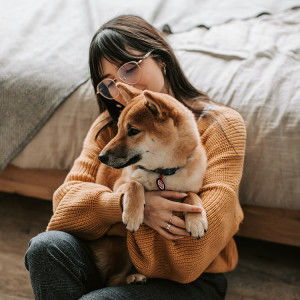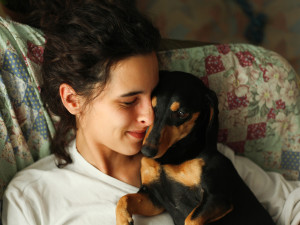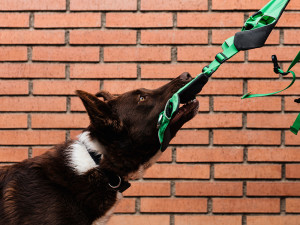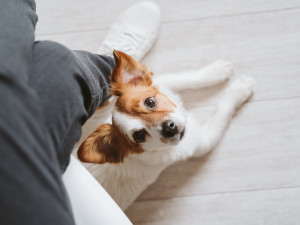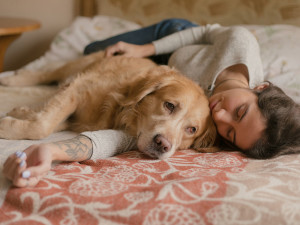There’s a High-Tech Training Solution For Your Dog’s Separation Anxiety
Like most things in 2023, there’s a Zoom link for this.
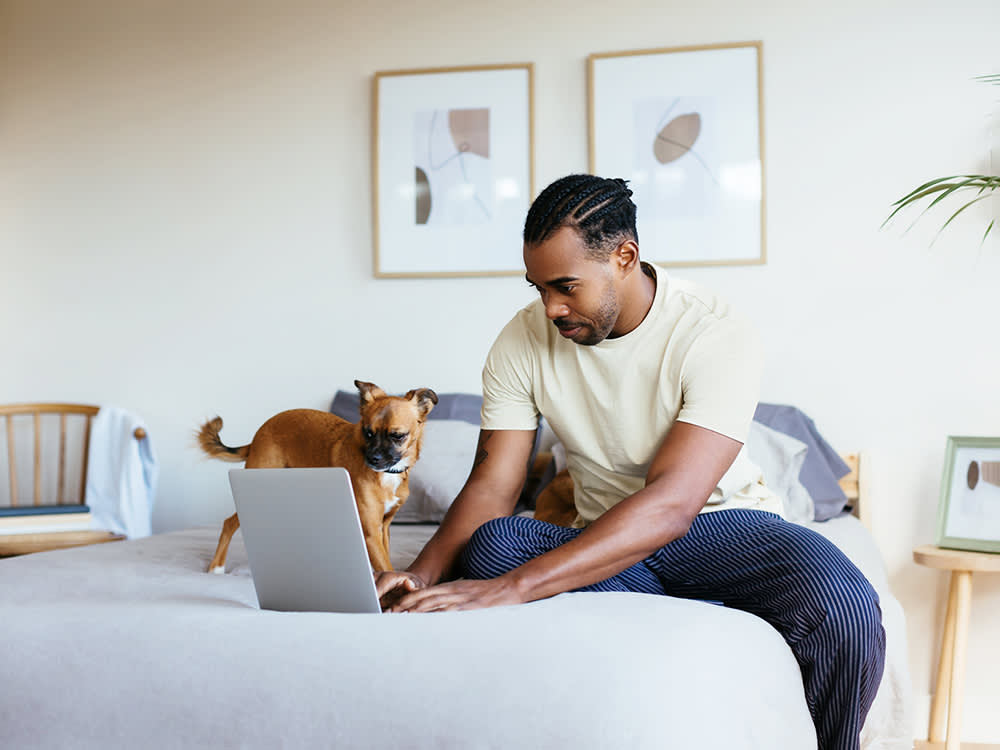
Share Article
It’s been three years (count ’em) since we were all told to stay inside our homes for an indefinite amount of time. During that excruciatingly confusing period, we told ourselves we loved to bake bread, do puzzles, and, most of all, that we were OK — insert always-relevant “this is fine” meme here. The one thing that was actually good about staying home for months on end was our dogs.
When they realized we were never leaving, they rewarded us with extra snuggle time and lots of opportunities of taking photos of them sleeping like baby angels. But, now that many of us are back in the office and just generally living our lives because society demands it, our dogs are left to cope on their own, which results in, yes, you guessed it, separation anxiety. And my dog Emma definitely has a pretty serious case of it.
Desperate to help Emma, I brought in multiple dog trainers, consulted four vets, cooked her food from scratch, gave her interactive food toys, and played calming music. I even hired a doggie masseuse. Results? Her separation anxiety only got worse: She didn’t stop barking, pacing, and peeing on the floor when I left. She even started chewing at my doorframe. Thankfully, there was a solution to my and Emma’s problem, and (a plus for your nervous pup) they didn’t include either of us having to leave the house.
The Shift Toward Online Dog Training
Malena DeMartini — a California-based dog trainer and graduate of the Academy for Dog Trainersopens in new tab under the guidance of Jean Donaldson — has focused solely on separation-anxiety cases. Over time, she has become one of the leading experts (if not the leading expert) on the condition. By using technology (smartphones, tablets, laptops, cameras), she is also transforming the way dogs, in general, are trained.

DeMartini and the 20-plus separation-anxiety trainers she has certified do not work with clients in person. Instead, they do the job online: meet via apps such as Zoom or FaceTime and create and share spreadsheets so clients know exactly how to train their dogs each day. The team even reviews video footage with clients to teach them how to read their dogs’ body language. Training online also offsets the complication of bringing someone into the home when the goal is to help the dog handle time alone.
DeMartini began offering online separation-anxiety training in 2008, saving her time and energy and, more importantly, allowing her to observe a dog in real time. Rather than review what went on after the fact, she could modify the training protocol online as the behavior was in progress.
Creating an Individualized Separation Anxiety Plan
Working with one of DeMartini’s trainers, Caryn Liles, who lives in Toronto, we began our online training sessions. I stacked books on a chair facing the front door and set my MacBook on top while Liles observed Emma while I went for a walk outside. The tiny pup had a threshold of 10 seconds — meaning Emma could only handle being alone in the house for 10 seconds. That was our starting point.
Until completing the separation-anxiety protocol, Emma could only be left alone in the house during her training sessions. “The first goal is to teach the dog, ‘Hey, you know what? You’re okay for a full second of being left alone, or three seconds,’” DeMartini says. And once they get to that point, they’re like, ‘The sky didn’t fall! Amazing!’” The training wouldn’t work if, for example, their pet parent then drove away and caught a two-hour movie. Note: When we do want to catch a movie or go out to dinner, my husband and I have recruited friends and pet sitters to keep Emma company. (For dogs who enjoy spending time with other pups, doggie daycare can be a great option; unfortunately, Emma’s not a fan.)
The morning following that assessment meeting, Liles sent me a Google Sheet titled “Mission One,” a series of 12 exercises that started with the following:
Open front door one inch, close it, return.
Stand outside the front door for one second, return.
Open the door one inch, close it, return.
Stand outside for one second, return.
Turn door handle, return.
At the start of each exercise, I grabbed my keys and purse from the kitchen and then put them back upon my return. I was instructed to wait 60 to 90 seconds between each exercise, at which point I would type into the spreadsheet a description of Emma’s behavior during my absence and what her recovery looked like.
While outside, I watch Emma on my iPhone through a camera mounted above the fireplace. If you have multiple smartphones or tablets, another option is to use an app that turns one device into a video camera and allows you to watch on another.
Making Quick Progress
Each day, Liles reviews the previous mission and then creates a new one based on the results. We repeated Mission One for seven days before graduating to five whole seconds out the door on Mission Two.
“I teach a dog to be relaxed in incredibly small increments,” DeMartini says about her training protocol. “People initially have a sort of pushback, if you will, like, ‘Oh, my gosh, we’re starting with one second? What? This is crazy! It’s gonna be the year 2037 before I ever leave my dog!’”
Thankfully, it doesn’t take a decade for most dogs to be desensitized to being alone, though some dogs need medication to help them relax enough to succeed, and some, unfortunately, can never get past their fear. Most of DeMartini’s clients complete training somewhere in the three-to six-month range (meaning the dog can handle being alone for four or five hours). But DeMartini hesitates to give time estimates. Each dog is different, and anxiety level does not necessarily predict speed.
Training Emma on her separation-anxiety fears is also improving her fears in other areas, too. By not losing it every time the front door creaks open, Emma has gained confidence overall. She no longer cocks an ear and furrows her brow when a construction crew bangs outside or televised gunshots ring out in surround sound. And rather than shake in terror in the car, Emma now puts her nose up to the window opening. When I glance over at Emma, flopped on her side napping peacefully in a sun patch on the rug, I know that we’re making progress.

Tracy Krulik, CTC, CSAT
Tracy Krulik, CTC, CSAT, is a Northern Virginia-based certified canine separation anxiety trainer and honors graduate of Jean Donaldson’s prestigious Academy for Dog Trainersopens in new tab. Krulik is also the founder and managing editor of iSpeakDogopens in new tab — a website and public awareness campaign to teach dog body language and behavior.
Related articles
![Muscular white pit bull stands on couch, looking out window to sunny fall day.]()
Separation Anxiety in Dogs
Does your dog freak out when you head for the door? Here’s some advice.
![Dog is biting his dog harness to take the dog for a walk]()
Nobody Likes to Be Labeled — Especially Your Dog
(Mis)labeling behaviors does more harm than good.
![Shy black dog walking with owner at the park.]()
How to Help an Anxious Dog Conquer Their Fears
Pro tips for boosting the confidence of a scaredy-cat dog.
Why Does My Dog Follow Me Everywhere?
They are the cutest little shadow.
Does Your Dog Need Anti-Anxiety Meds?
How to cope with dog anxiety—from training to medication.

